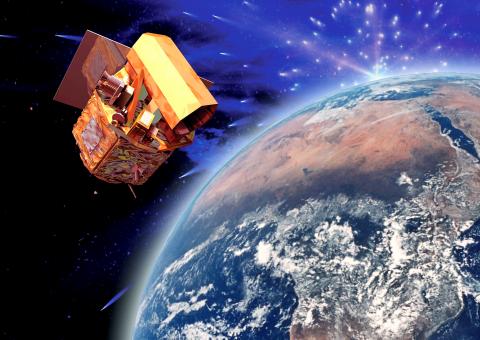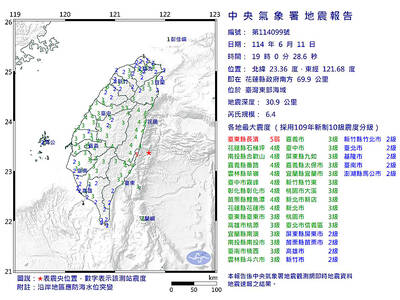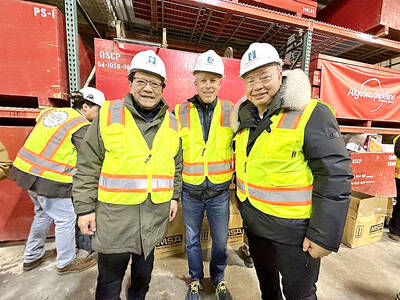Celebrating 10 years since FORMOSAT-2 — the first Earth observation satellite developed in Taiwan — was launched, the National Applied Research Laboratories’ National Space Organization (NSPO) said yesterday that a series of conferences and exhibitions are to be held to let the public know more about its contribution to the nation.
At a press conference at the Ministry of Science and Technology, NSPO Director Chang Guey-shin (張桂祥) said since FORMOSAT-2 was launched in California on May 21, 2004, it has orbited the Earth 50,435 times and taken pictures of 112,652km2 of the planet’s surface.
He said that although the satellite was originally designed to last five years, it has performed well beyond its worth, providing valuable images for scientific research, environmental monitoring, natural disaster prevention and evaluation, urban planning and other applications for the past 10 years.

Photo courtesy of the National Space Organization
FORMOSAT-2 is not the only the first satellite developed and operated by the NSPO, it is also the only satellite in the world that pays Taiwan a “daily revisit” — taking images twice a day of a location within its fixed orbit, Chang said.
The satellite, used for academic and non-commercial purposes, can capture images of about 80 percent of the planet’s surface, including polar areas that most commercial satellites do not cover, which is helpful in understanding the melting ice at the poles and its relation to climate change, he said.
The satellites most important contributions were providing the earliest images after the huge tsunami struck Southeast Asia in 2004, the magnitude 7.8 earthquake that struck China’s Sichuan Province in 2008, Typhoon Morakot, which devastated southern Taiwan in 2009, as well as the tsunami that engulfed northeastern Japan in 2011.
Images taken by FORMOSAT-2 that showed a barrier lake which formed after the Sichuan earthquake were sent to the Chinese government and the water was immediately dredged to prevent further disaster, Chang said, adding that images taken in northeastern Japan for two weeks after the tsunami struck were sent to the Japanese government for flood evaluation.
The NSPO said a conference is to be held on Wednesday next week in Taipei and public exhibitions are to be held in northern, central and southern Taiwan, starting at the National Taiwan Science Education Center in Taipei on May 24.

STAY AWAY: An official said people should avoid disturbing snakes, as most do not actively attack humans, but would react defensively if threatened Taitung County authorities yesterday urged the public to stay vigilant and avoid disturbing snakes in the wild, following five reported snakebite cases in the county so far this year. Taitung County Fire Department secretary Lin Chien-cheng (林建誠) said two of the cases were in Donghe Township (東河) and involved the Taiwan habus, one person was bit by a Chinese pit viper near the South Link Railway and the remaining two were caused by unidentified snakes. He advised residents near fields to be cautious of snakes hiding in shady indoor areas, especially when entering or leaving their homes at night. In case of a

A magnitude 6.4 earthquake struck off the coast of Hualien County in eastern Taiwan at 7pm yesterday, the Central Weather Administration (CWA) said. The epicenter of the temblor was at sea, about 69.9km south of Hualien County Hall, at a depth of 30.9km, it said. There were no immediate reports of damage resulting from the quake. The earthquake’s intensity, which gauges the actual effect of a temblor, was highest in Taitung County’s Changbin Township (長濱), where it measured 5 on Taiwan’s seven-tier intensity scale. The quake also measured an intensity of 4 in Hualien, Nantou, Chiayi, Yunlin, Changhua and Miaoli counties, as well as

Credit departments of farmers’ and fishers’ associations blocked a total of more than NT$180 million (US$6.01 million) from being lost to scams last year, National Police Agency (NPA) data showed. The Agricultural Finance Agency (AFA) said last week that staff of farmers’ and fishers’ associations’ credit departments are required to implement fraud prevention measures when they serve clients at the counter. They would ask clients about personal financial management activities whenever they suspect there might be a fraud situation, and would immediately report the incident to local authorities, which would send police officers to the site to help, it said. NPA data showed

ENERGY RESILIENCE: Although Alaska is open for investments, Taiwan is sourcing its gas from the Middle East, and the sea routes carry risks, Ho Cheng-hui said US government officials’ high-profile reception of a Taiwanese representative at the Alaska Sustainable Energy Conference indicated the emergence of an Indo-Pacific energy resilience alliance, an academic said. Presidential Office Secretary-General Pan Men-an (潘孟安) attended the conference in Alaska on Thursday last week at the invitation of the US government. Pan visited oil and gas facilities with senior US officials, including US Secretary of the Interior Doug Burgum, US Secretary of Energy Chris Wright, Alaska Governor Mike Dunleavy and US Senator Daniel Sullivan. Pan attending the conference on behalf of President William Lai (賴清德) shows a significant elevation in diplomatic representation,